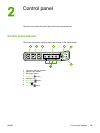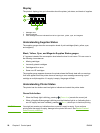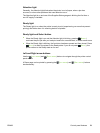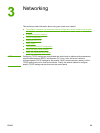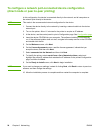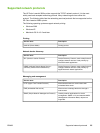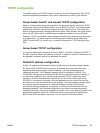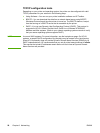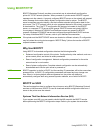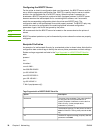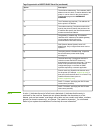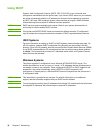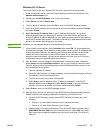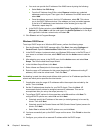TCP/IP configuration
To operate properly on a TCP/IP network, the printer must be configured with valid TCP/IP
network configuration parameters, such as an IP address that is valid for your network.
Server-based, AutoIP, and manual TCP/IP configuration
When in a factory-default state and powered on, the printer will first try to obtain its TCP/IP
configuration using a server-based method, such as BOOTP or DHCP. If the server-based
method fails, the printer will then be configured using the AutoIP protocol. The printer may
also be configured manually. Manual-based tools include a Web browser, the printer control
panel, the HP Toolbox utility, or SNMP-based management software (such as HP Web
Jetadmin). TCP/IP configuration values assigned manually will be retained when the printer
is powered off/on. The printer can also be reconfigured to use either server-based only
(BOOTP and/or DHCP), or AutoIP only, or manual configuration of TCP/IP settings at any
time.
Server-based TCP/IP configuration
In its factory-default state, the printer will first try DHCP, if this fails it will then try BOOTP, if
this fails, it will then obtain an IP address via AutoIP. In addition, a default IP address will not
be assigned if a network cable is not attached to the printer.
Default IP address configuration
A default IP address will be assigned via the AutoIP protocol if the server based methods
fail. When DHCP or BOOTP fails to obtain an IP address, the printer uses a link-local
addressing technique to assign a unique IP address. Link-local addressing may be
referenced as AutoIP. The IP address assigned will be in the range of 169.254.1.0 to
169.254.254.255 (commonly referenced as 169.254/16), and should be valid. However, it
can be further modified for your network using supported TCP/IP configuration tools if
necessary. With link-local addresses, subnetting is not used. The subnet mask will be
255.255.0.0, and cannot be changed. Link-local addresses will not route off the local link,
and access to or from the Internet will not be available. The default gateway address will be
the same as the link-local address. If a duplicate address is sensed, the printer will
automatically reassign its address, if necessary, in accordance with standard link-local
addressing methods. The IP address configured on your printer may be determined by
inspecting the network configuration page for the printer. Since it may take some time for the
server-based protocols to time out, the AutoIP process can be sped up by disabling the
BOOTP and DHCP services on the printer. This can be done via a Web browser.
ENWW TCP/IP configuration 27



